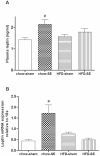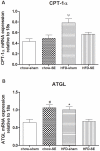Maternal cigarette smoke exposure contributes to glucose intolerance and decreased brain insulin action in mice offspring independent of maternal diet
- PMID: 22076142
- PMCID: PMC3208635
- DOI: 10.1371/journal.pone.0027260
Maternal cigarette smoke exposure contributes to glucose intolerance and decreased brain insulin action in mice offspring independent of maternal diet
Abstract
Background: Maternal smoking leads to intrauterine undernutrition and is associated with low birthweight and higher risk of offspring obesity. Intrauterine smoke exposure (SE) may alter neuroendocrine mediators regulating energy homeostasis as chemicals in cigarette smoke can reach the fetus. Maternal high-fat diet (HFD) consumption causes fetal overnutrition; however, combined effects of HFD and SE are unknown. Thus we investigated the impact of combined maternal HFD and SE on adiposity and energy metabolism in offspring.
Method: Female Balb/c mice had SE (2 cigarettes/day, 5 days/week) or were sham exposed for 5 weeks before mating. Half of each group was fed HFD (33% fat) versus chow as control. The same treatment continued throughout gestation and lactation. Female offspring were fed chow after weaning and sacrificed at 12 weeks.
Results: Birthweights were similar across maternal groups. Faster growth was evident in pups from SE and/or HFD dams before weaning. At 12 weeks, offspring from HFD-fed dams were significantly heavier than those from chow-fed dams (chow-sham 17.6±0.3 g; chow-SE 17.8±0.2 g; HFD-sham 18.7±0.3 g; HFD-SE 18.8±0.4 g, P<0.05 maternal diet effect); fat mass was significantly greater in offspring from chow+SE, HFD+SE and HFD+sham dams. Both maternal HFD and SE affected brain lactate transport. Glucose intolerance and impaired brain response to insulin were observed in SE offspring, and this was aggravated by maternal HFD consumption.
Conclusion: While maternal HFD led to increased body weight in offspring, maternal SE independently programmed adverse health outcomes in offspring. A smoke free environment and healthy diet during pregnancy is desirable to optimize offspring health.
Conflict of interest statement
Figures






Similar articles
-
Maternal High Fat Diet Consumption Exaggerates Metabolic Disorders in Mice With Cigarette-Smoking Induced Intrauterine Undernutrition.Front Nutr. 2021 Mar 16;8:638576. doi: 10.3389/fnut.2021.638576. eCollection 2021. Front Nutr. 2021. PMID: 33796546 Free PMC article.
-
Maternal overnutrition impacts offspring adiposity and brain appetite markers-modulation by postweaning diet.J Neuroendocrinol. 2010 Aug;22(8):905-14. doi: 10.1111/j.1365-2826.2010.02005.x. Epub 2010 Apr 6. J Neuroendocrinol. 2010. PMID: 20403085
-
Maternal High-Fat Diet During Pre-Conception and Gestation Predisposes Adult Female Offspring to Metabolic Dysfunction in Mice.Front Endocrinol (Lausanne). 2022 Jan 17;12:780300. doi: 10.3389/fendo.2021.780300. eCollection 2021. Front Endocrinol (Lausanne). 2022. PMID: 35111136 Free PMC article.
-
Animal models of maternal high fat diet exposure and effects on metabolism in offspring: a meta-regression analysis.Obes Rev. 2017 Jun;18(6):673-686. doi: 10.1111/obr.12524. Epub 2017 Mar 30. Obes Rev. 2017. PMID: 28371083 Free PMC article. Review.
-
Repercussions of maternal exposure to high-fat diet on offspring feeding behavior and body composition: a systematic review.J Dev Orig Health Dis. 2021 Apr;12(2):220-228. doi: 10.1017/S2040174420000318. Epub 2020 Apr 27. J Dev Orig Health Dis. 2021. PMID: 33754967
Cited by
-
Heat or Burn? Impacts of Intrauterine Tobacco Smoke and E-Cigarette Vapor Exposure on the Offspring's Health Outcome.Toxics. 2018 Aug 1;6(3):43. doi: 10.3390/toxics6030043. Toxics. 2018. PMID: 30071638 Free PMC article. Review.
-
Maternal Smoking and Metabolic Health Biomarkers in Newborns.PLoS One. 2015 Nov 23;10(11):e0143660. doi: 10.1371/journal.pone.0143660. eCollection 2015. PLoS One. 2015. PMID: 26599278 Free PMC article.
-
Developmental cigarette smoke exposure II: Kidney proteome profile alterations in 6 month old adult offspring.Reprod Toxicol. 2016 Oct;65:425-435. doi: 10.1016/j.reprotox.2016.05.008. Epub 2016 May 18. Reprod Toxicol. 2016. PMID: 27208485 Free PMC article.
-
Developmental Origins of Health Span and Life Span: A Mini-Review.Gerontology. 2018;64(3):237-245. doi: 10.1159/000485506. Epub 2018 Jan 12. Gerontology. 2018. PMID: 29324453 Free PMC article. Review.
-
Cigarette smoking and brain regulation of energy homeostasis.Front Pharmacol. 2012 Jul 25;3:147. doi: 10.3389/fphar.2012.00147. eCollection 2012. Front Pharmacol. 2012. PMID: 22848202 Free PMC article.
References
-
- WHO. Obesity and overweight. 2003. Available from: http://wwwwhoint/dietphysicalactivity/publications/facts/obesity/en/prin....
-
- Dietz WH. Childhood Weight Affects Adult Morbidity and Mortality. J Nutr. 1998;128:411S–414S. - PubMed
-
- Power C, Jefferis BJ. Fetal environment and subsequent obesity: a study of maternal smoking. Int J Epidemiol. 2002;31:413–419. - PubMed
Publication types
MeSH terms
Substances
LinkOut - more resources
Full Text Sources
Medical

